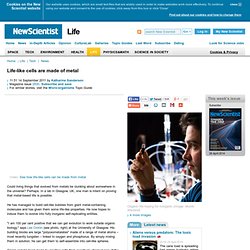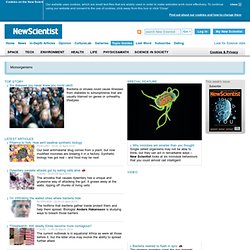

Scientist creates lifelike cells out of metal. Scientists trying to create artificial life generally work under the assumption that life must be carbon-based, but what if a living thing could be made from another element?

One British researcher may have proven that theory, potentially rewriting the book of life. Lee Cronin of the University of Glasgow has created lifelike cells from metal — a feat few believed feasible. The discovery opens the door to the possibility that there may be life forms in the universe not based on carbon, reports New Scientist. Even more remarkable, Cronin has hinted that the metal-based cells may be replicating themselves and evolving. "I am 100 percent positive that we can get evolution to work outside organic biology," he said.
The high-functioning "cells" that Cronin has built are constructed from large polyoxometalates derived from a range of metal atoms, like tungsten. The metallic bubbles are certainly cell-like, but are they actually alive? The early results have been encouraging. Video - Creating life-like cells from metal. Life-like cells are made of metal - life - 14 September 2011. Video: See how life-like cells can be made from metal Could living things that evolved from metals be clunking about somewhere in the universe?

Perhaps. In a lab in Glasgow, UK, one man is intent on proving that metal-based life is possible. He has managed to build cell-like bubbles from giant metal-containing molecules and has given them some life-like properties. He now hopes to induce them to evolve into fully inorganic self-replicating entities. "I am 100 per cent positive that we can get evolution to work outside organic biology," says Lee Cronin (see photo, right) at the University of Glasgow. Cronin and his team begin by creating salts from negatively charged ions of the large metal oxides bound to a small positively charged ion such as hydrogen or sodium. When the two salts meet, they swap parts and the large metal oxides end up partnered with the large organic ions. It's early days; other synthetic biologists are reserving judgement for now.
More From New Scientist Recommended by. Life-like cells are made of metal - life - 14 September 2011. Micro-organisms. Cookies on the New Scientist website close Our website uses cookies, which are small text files that are widely used in order to make websites work more effectively.

To continue using our website and consent to the use of cookies, click away from this box or click 'Close' Find out about our cookies and how to change them Log in Your login is case sensitive I have forgotten my password close My New Scientist Look for Science Jobs Microorganisms Six diseases you never knew you could catch Bacteria or viruses could cause illnesses from diabetes to schizophrenia that are usually blamed on genes or unhealthy lifestyles Pharma to fork: How we'll swallow synthetic biology FEATURE: 20:00 10 April 2014 Our best antimalarial drug comes from a plant, but now modified microbes are brewing it in a factory.
Dysentery parasite attacks gut by eating cells alive TODAY: 18:00 09 April 2014 I'm infiltrating the walled cities where bacteria hide INTERVIEW: 20:00 02 April 2014 TODAY: 11:45 26 March 2014 Most read Subscribe.